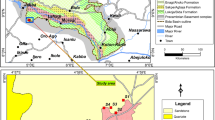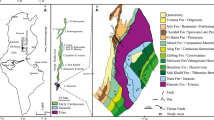Abstract
This paper describes in detail phosphate minerals occurring in refractory clays of Missouri and their effect on the refractory degree of the clays. The minerals identified include carbonate-fluorapatite (francolite), crandallite, goyazite, wavellite, variscite and strengite. It is emphasized that these phosphates occur only in local isolated concentrations, and not generally in Missouri refractory clays.
The Missouri fireclay region comprises 2 districts, northern and southern, separated by the Missouri River. In this region, clay constitutes a major part of the Lower Pennsylvanian Cheltenham Formation. The original Cheltenham mud was an argillic residue derived from leaching and dissolution of pre-Pennsylvanian carbonates. The mud accumulated on a karstic erosion surface truncating the pre-Cheltenham rocks. Fireclays of the northern district consist mainly of poorly ordered kaolinite, with variable but minor amounts of illite, chlorite and fine-grained detrital quartz. Clays of the southern district were subjected to extreme leaching that produced well-ordered kaolinite flint clays. Local desilication formed pockets of diaspore, or more commonly, kaolinite, with oolite-like nubs or burls of diaspore (“burley” clay).
The phosphate-bearing materials have been studied by X-ray diffraction (XRD), scanning electron microscopy-energy dispersive spectral analysis (SEM-EDS) and chemical analysis. Calcian goyazite was identified in a sample of diaspore, and francolite in a sample of flint clay. A veinlet of wavellite occurs in flint clay at one locality, and a veinlet of variscite-strengite at another locality.
The Missouri flint-clay-hosted francolite could not have formed in the same manner as marine francolite. The evidence suggests that the Cheltenham francolite precipitated from ion complexes in pore water, nearly simultaneously with crystallization of kaolinite flint clay from an alumina-silica gel. Calcian goyazite is an early diagenetic addition to its diaspore host. The wavellite and variscite-strengite veinlets are secondary, precipitated from ion complexes in ground water percolating along cracks in the flint clay. The flint clay host of the variscite-strengite veinlet contains strontian crandallite. All of the phosphates contain significant amounts of strontium. The source of P, Ca and Sr was the marine carbonates. Dissolution of these carbonates produced the argillic residue that became the primordial Cheltenham paludal mud, which ultimately altered to fireclay.
Preliminary firing tests show that the presence of phosphates lowers fusion temperature. However, it is not clear whether poor refractoriness is due to the presence of phosphates, per se, or to Ca, Sr and other alkaline elements present in the phosphates.
Similar content being viewed by others
References
Altschuler ZS. 1973. The weathering of phosphate deposits—Geochemical and environmental aspects. In: Griffith EJ et al., editor. Environmental phosphorous handbook. New York: J Wiley, p 33–96.
Altschuler ZS, Cathcart JB, Young EJ. 1964. Geology and geochemistry of the Bone Valley Formation and its phosphate deposits in west-central Florida. Guidebook, field trip No., 6, Geol Soc Am Annu Meet; 1964. 68 p.
Ames LL Jr. 1959. The genesis of carbonate apatite. Econ Geol 54:829–841.
Bache BW. 1963. Aluminum and iron phosphate studies relating to soils: I. Solution and hydrolysis of variscite and strengite. J Soil Sci 14:14–123.
Baumgart W. 1984. Refractories. In: Baumgart W, Dunham AC, Amstutz GC, editors. Process mineralogy of ceramic materials. New York: Elsevier, p 80–103.
Bliskovskiy VZ, Yefinova VA, Romanova LV. 1967. The strontium contents of phosphorites. Geochem Int 4:4–1190.
Botinelly T. 1976. A review of the minerals of the alunite-jarosite, beudantite, and plumbogummite groups. J Research, US Geol Surv 4(2):213–216.
Brindley GW, Brown G, editors. 1980. Crystal structures of clay minerals and their X-ray identification. Monograph No. 5. London: Mineral Soc. 495 p.
Chang SC, Jackson ML. 1958. Soil phosphorous fractions in some representative soils. J Soil Sci 9:9–119.
Cook PJ. 1970. Repeated diagenetic calcitization, phosphatization, and silicification in the Phosphoria Formation. Geol Soc Am Bull 81:2107–2116.
Cowgill UM, Hutchinson GE, Joensuu O. 1963. An apparently triclinic dimorph of crandallite from a tropical swamp sediment in El Peten, Guatemala. Am Mineral 48:1144–1153.
Deans T. 1940. Francolite in sedimentary ironstones of the Coal Measures. Mineral Mag 25:25–139.
Dill HG, Fricke A, Henning KH, Theune, CH. 1995. Aluminum phosphate mineralization from the hypogene La Vanguardia kaolin deposit (Chile). Clay Miner 30:30–256.
Frondell C. 1958. Geochemical scavenging of strontium. Science 128:128–1624.
Frondell C, Ito J, Montgomery A. 1968. Scandium content of some aluminum phosphates. Am Mineral 53:53–1231.
Gaudette HE, Lyons WB. 1980. Phosphate geochemistry in nearshore carbonate sediments: A suggestion of apatite formation. Soc Econ Paleontol Mineral Spec Publ 29:29–225.
Grawe OR. 1943. Metatorbernite in Missouri flint fire clays. In: McQueen HS, editor. Fire clay districts of east-central Missouri. Missouri Geol Surv Water Res 25 (2nd Ser): 153.
Hsu PH, Jackson ML. 1960. Inorganic phosphate transformations by chemical weathering in soils as influenced by pH. Soil Sci 90:16–24.
Huang WH, Keller WD. 1972. Geochemical mechanism for the dissolution, transport, and deposition of aluminum in the zone of weathering. Clays Clay Miner 20:69–74.
Keller DJ. 1992. Mineralogy and geochemistry of carbonaceous flint clays in east-central Missouri [M.S. thesis]. Rolla, MO: Univ Missouri. 149 p.
Keller DJ, Bolter E. 1993. Mineralogy, geochemistry, and firing properties of carbonaceous flint clays of east-central Missouri [abstract]. Geol Soc Am Abstr with Prog, North-Central Section Annu Meet; Rolla, MO. p 29.
Keller WD., 1952a. Observations on the origin of Missouri high-alumina clays. Problems of clay and laterite genesis; Symp Annu Meet AIMME; 19–22 Feb 1951; St. Louis, MO. New York: AIMME. p 112–135.
Keller WD., 1952b. Torbernite in Missouri refractory clay. Am Mineral 37:37–128.
Keller WD. 1979. Diaspore—A depleted non-renewable mineral resource of Missouri. Missouri Div Geol Land Surv, Dept Nat Res Educ Ser 6. 40 p.
Keller WD, Hall, RB, Foord EE, Keller DJ. 1992. Phosphate minerals in some fireclays of Missouri. CMS News Aug 1992:1992–29.
Keller WD, Stevens RP. 1983. Physical arrangement of high alumina clay types in Missouri clay deposit and implication for their genesis. Clays Clay Miner 31:31–434.
Keller WD, Westcott JF, Bledsoe AO. 1954. The origin of Missouri fire clays. Clays Clay Miner 2:2–46.
Krauskopf KB. 1967. Introduction to geochemistry. New York: McGraw-Hill. 721 p.
Loughnan FC. 1970. Flint clay in the coal-barren Triassic of the Sydney Basin. J Sed Petrol 40:40–828.
McArthur JM. 1978. Systematic variations in the content of Na, Sr, CO3 and SO4 in marine carbonate-fluorapatite and their relation to weathering. Chem Geol 21:89–112.
McClellan GH. 1980. Mineralogy of carbonate fluorapatites. J Geol Soc London 137:137–681.
McConnell D. 1937. The substitution of SiO4- and SO4- groups for PO4-groups in the apatite structure; ellestadite, the end member. Am Mineral 22:977–986.
McQueen HS. 1943. Geology of the fire clay districts of east-central Missouri. Missouri Geol Surv Water Res 25 (2nd Ser). 250 p.
Milton C, Axelrod JM, Carron MK, MacNeil FS. 1958. Gorceixite from Dale County, Alabama. Am Mineral 43:688–694.
Norrish K. 1968. Some phosphate minerals in soils. Trans 9th Int Cong Soil Sci 2. New York: Elsevier, p 713–723.
Nriagu JO. 1976. Phosphate-clay mineral relations in soils and sediments. Can J Earth Sci 13:13–736.
Palache C, Berman H, Frondel C. 1951. The system of mineralogy (Dana), 7th ed, vol 2. New York: J. Wiley. 1124 p.
Pevear DR. 1966. The estuarine formation of United States coastal plain phosphorite. Econ Geol 61:61–256.
Rankama K, Sahama TG. 1950. Geochemistry. Chicago: Univ Chicago Pr. 912 p.
Robbins C, Keller, WD. 1952. Clays and other non-carbonate minerals in some limestones. J Sed Petrol 22:22–152.
Rooney TP, Kerr PF. 1967. Mineralogic nature and origin of phosphorite, Beaufort County, North Carolina. Geol Soc Am Bull 78:731–748.
Rueff AW, Hays E. 1991. Chemical and physical properties of selected stone resources in northeast Missouri. Missouri Dept Nat Res, Div Geol Land Survey Open-File Report 91-83-MR. 156 p.
Schroo H. 1963. A study of highly phosphatic soils in a karst region of the humid tropics. Neth J Agric Sci 11:11–231.
Stack CE, Westcott JF, Miles R. 1990. East-central Missouri fireclays, tills, and associated soils. Guidebook to field excursion, Clay Miner Soc 27th Annu Meet. 41 p.
Sweatman TR. 1961. Gorceixite—A naturally occurring soil phosphate mineral [abstract]. Aust J Sci 24:24–243.
Taylor SR. 1964. Abundance of chemical elements in the continental crust: A new table. Geochim Cosmochim Acta 28:28–1285.
Tourtelot HA, Brenner-Tourtelot EF. 1977. Lithium in flint clay, bauxite, related high-alumina material and associated sedimentary rocks in the United States—A preliminary survey. US Geol Surv Open-File Report 77–786. 46 p.
Tourtelot HA, Brenner-Tourtelot EF. 1978. Lithium, a preliminary survey of its mineral occurrence in flint clay and related rock types in the United States. Energy 3:263–277.
Triplehorn DM, Bohor B. 1983. Goyazite in kaolinitic altered tuff beds of Cretaceous age near Denver, Colorado. Clays Clay Miner 31:299–304.
Vasileva ZV. 1958. Sulfur-bearing apatites. Geokhimiya 4:4–470.
Weaver BL, and Tarney J. 1984. Empirical approach to estimating the composition of the continental crust. Nature 310:310–577.
Author information
Authors and Affiliations
Rights and permissions
About this article
Cite this article
Hall, R.B., Foord, E.E., Keller, D.J. et al. Phosphates in Some Missouri Refractory Clays. Clays Clay Miner. 45, 353–364 (1997). https://doi.org/10.1346/CCMN.1997.0450306
Received:
Accepted:
Published:
Issue Date:
DOI: https://doi.org/10.1346/CCMN.1997.0450306




